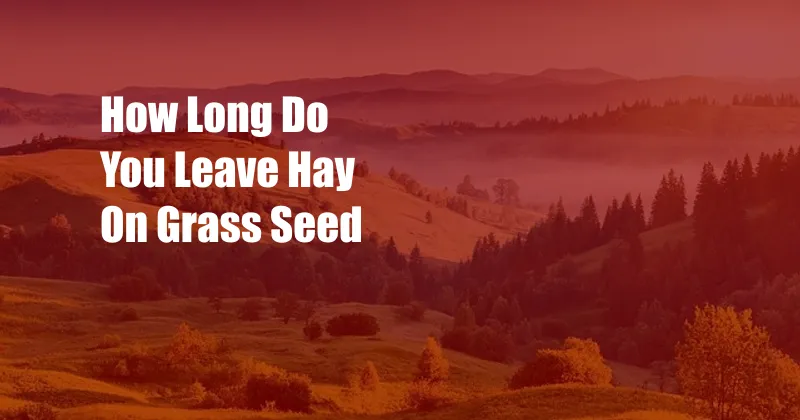
How Long Do You Leave Hay on Grass Seed?
As a homeowner, I’ve always taken pride in maintaining a lush, verdant lawn. A few years ago, I embarked on a project to revitalize my backyard’s grassy expanse. After meticulously preparing the soil and sowing fresh grass seed, I stumbled upon a curious question: how long should I leave hay on the grass seed? My quest for the answer led me down a path of research and experimentation, which I’m delighted to share with you today.
Before delving into the specifics, let’s explore the rationale behind covering grass seed with hay. Hay, a dried form of grass, serves as a protective layer, shielding the delicate seeds from harsh sunlight, wind, and erosion. It also helps retain moisture, promoting optimal germination and growth. However, leaving hay on for an extended period can hinder the grass’s ability to establish roots and absorb sunlight.
Timing is Key
The golden rule for leaving hay on grass seed is to remove it once the grass seedlings emerge. This typically occurs within 7 to 14 days after sowing, depending on the seed type, soil conditions, and weather. Monitoring the seedbed closely is crucial to ensure timely removal. Leaving hay on for too long can lead to mold growth and stunted grass growth.
To determine if the grass seedlings have emerged, gently lift a corner of the hay covering. If you notice tiny green shoots poking through the soil, it’s time to remove the hay. Avoid pulling or yanking at the hay, as this can damage the tender seedlings.
Benefits of Hay Cover
- Protects seeds from sunlight, wind, and erosion
- Retains moisture, aiding germination
- Suppresses weed growth
- Regulates soil temperature
Expert Tips
In addition to timing, here are some expert tips to consider when using hay as a seed cover:
- Use a thin layer: Avoid covering the seedbed with thick layers of hay. A thin, uniform covering is sufficient.
- Water regularly: Keep the seedbed moist, but not waterlogged. Water deeply and infrequently, allowing the soil to dry out slightly between waterings.
- Fertilize after emergence: Once the grass seedlings have emerged, apply a balanced fertilizer to promote healthy root development and growth.
- Mow carefully: When the grass reaches a height of 3-4 inches, mow it to a height of 2-2.5 inches. This encourages lateral growth and root development.
By following these tips, you can create a thriving lawn that will be the envy of your neighborhood. So, the next time you sow grass seed, remember the importance of timely hay removal. May your lawn bloom with verdant beauty for seasons to come!
FAQs
Q: Can I leave hay on grass seed for more than two weeks?
A: No, it is not recommended to leave hay on grass seed for more than two weeks. Extended periods of hay cover can hinder grass growth and promote mold growth.
Q: What type of hay should I use?
A: Choose a clean, weed-free hay such as straw, hay, or peat moss. Avoid using hay containing seeds, as they can compete with the grass seedlings.
Q: Should I remove the hay if it rains?
A: Yes, it is advisable to remove the hay if it rains heavily. Excess moisture can create an environment conducive to mold growth. Replace the hay after the rain subsides.
Q: What are the signs of overwatering?
A: Overwatering can lead to yellowing or browning grass, stunted growth, and increased susceptibility to disease. Avoid waterlogging the seedbed and allow the soil to dry out slightly between waterings.
Q: How often should I water the seedbed?
A: Water the seedbed deeply and infrequently, allowing the soil to dry out slightly between waterings. The frequency of watering will depend on factors such as soil type, weather, and seed type.